Night-Time Light Remote Sensing Mapping: Construction and Analysis of Ethnic Minority Development Index
Abstract
1. Introduction
2. Materials and Methods
2.1. Materials
2.1.1. Study Area
2.1.2. Data Sources
2.2. Methods
2.2.1. NPP-VIIRS Data Preprocessing
2.2.2. Construction of the Development Index of Various Ethnic Minorities
2.2.3. Distribution of Ethnic Minorities
3. Results and Accuracy Verification
3.1. Ethnic Minority Development Index
3.2. Ethnic Minority Distribution Results
3.3. Accuracy Verification
4. Discussion
4.1. Significance to the Development of Ethnic Minorities
4.2. The Relationship between National Development and Government
4.3. Influence on Night-Time Light Remote Sensing Mapping
4.4. Significance of Cultural Protection of Ethnic Minorities
5. Conclusions
Author Contributions
Funding
Acknowledgments
Conflicts of Interest
References
- Ray, A.K. Measurement of social development: An international comparison. Soc. Indic. Res. 2008, 86. [Google Scholar] [CrossRef]
- Fan, Q.; Lv, J.D.; Li, M. Prediction of GDP in Northeast China Based on Nighttime Light Data. Remote Sens. Environ. 2019, 34, 3–10. [Google Scholar]
- Shi, K.F.; Yu, B.L.; Huang, Y.X.; Hu, Y.J.; Yin, B.; Chen, Z.Q.; Chen, L.J.; Wu, J.P. Evaluating the Ability of NPP-VIIRS Nighttime Light Data to Estimate the Gross Domestic Product and the Electric Power Consumption of China at Multiple Scales: A Comparison with DMSP-OLS Data. Remote Sens. 2014, 6, 1705–1724. [Google Scholar] [CrossRef]
- Wang, J.N.; Lu, Y.T.; Zhou, J.S.; Li, Y.; Cao, D. Analysis of China resource-environment Gini coefficient based on GDP. China Environ. Sci. 2006, 26, 111–115. [Google Scholar]
- Liang, Y.J.; Xu, Z.M. Modeling the Spatial Distribution of Population Based on Night Light Radiation and LUCC: A Case Study in Ganzhou District, Zhangye Municipality. J. Glaciol. Geocryol. 2012, 34, 999–1006. [Google Scholar]
- Doll, C.N.; Pachauri, S. Estimating rural populations without access to electricity in developing countries through night-time light satellite imagery. Energy Policy 2010, 38, 5661–5670. [Google Scholar] [CrossRef]
- Wang, Z.; Chen, J.H.; Cui, M.J. Prediction of GDP in Northeast China Based on Nighttime Light Data. Mine Surv. 2018, 46, 27–33. [Google Scholar]
- Li, X.H.; Chen, J.Z. Study on the Economic Development Model of Ethnic Minorities from the Perspective of International Comparison Reg. Reg. Econ. Rev. 2020, 3, 18–24. [Google Scholar] [CrossRef]
- Lu, M. A Study on the Status Quo and Countermeasures of Economic Development in China’s Ethnic Minority Regions. Mod. Econ. Inf. 2020, 3, 186–187. [Google Scholar]
- Jing, C.M. Status Quo of Income Gap in Western Ethnic Area and Strategy Analysis. J. Northwest Univ. Natl. 2005, 6, 80–86. [Google Scholar]
- Li, J.J. A Case Study of Economic Disparity in Ethnic Autonomous Regions and Its Countermeasures. J. Cent. Univ. Natl. 2008, 1, 14–24. [Google Scholar] [CrossRef]
- Gao, Z.G.; Liu, W. Regional Economic Differences and Coordinated Development in Northwest Minority Areas: Taking Xinjiang as an Example. Nankai J. 2016, 3, 147–160. [Google Scholar]
- Dai, M.; Wang, P.; Li, Y.X. Analysis of Economic Disparities and Influencing Factors in Northwest Minority Regions. Financ. Account. Mon. 2017, 12, 108–113. [Google Scholar] [CrossRef]
- Zheng, C.D. A Study on the “Five Development Concepts” and Comprehensive Development of the Social Economy in Ethnic Areas. J. Ethnol. 2017, 8, 1–21, 94–97. [Google Scholar] [CrossRef]
- Luo, J.; Zhuang, Z.X. The variation trend of economic development in the ethnic minority regions of southwest borderland since the launch of western development in china—Based on Empirical Studies in Guangxi and Yunnan from 1995 to 2014. Guangxi Ethn. Stud. 2017, 5, 156–164. [Google Scholar]
- Croft, T.A. Nighttime images of the earth from space. Sci. Am. 1978, 239, 86–98. [Google Scholar] [CrossRef]
- Li, D.R.; Li, X. An Overview on Data Mining of Nighttime Light Remote Sensing. Acta Surv. Mapp. 2015, 44, 591–601. [Google Scholar] [CrossRef]
- Elvidge, C.D.; Baugh, K.E.; Kihn, E.A.; Kroehl, H.W.; Davis, E.R.; Davis, C.W. Relation between satellite observed visible-near infrared emissions, population, economic activity and electric power consumption. Int. J. Remote Sens. 1997, 18, 1373–1379. [Google Scholar] [CrossRef]
- Elvidge, C.D.; Baugh, K.E.; Dietz, J.B.; Bland, T.; Sutton, P.C.; Kroehl, H.W. Radiance calibration of DMSP-OLS low-light imaging data of human settlements. Remote Sens. Environ. 1999, 68, 77–88. [Google Scholar] [CrossRef]
- Ghosh, T.; Anderson, S.; Powell, R.L.; Sutton, P.C.; Elvidge, C.D. Estimation of Mexico’s informal economy and remittances using nighttime imagery. Remote Sens. 2009, 1, 418–444. [Google Scholar] [CrossRef]
- Li, X.; Xu, H.M.; Chen, X.L.; Li, C. Potential of NPP-VIIRS Nighttime Light Imagery for Modeling the Regional Economy of China. Remote Sens. 2013, 5, 3057–3081. [Google Scholar] [CrossRef]
- Doll, C.H.; Muller, J.P.; Elvidge, C.D. Night-time imagery as a tool for global mapping of socioeconomic parameters and greenhouse gas emissions. Ambio J. Hum. Environ. 2000, 29, 157–162. [Google Scholar] [CrossRef]
- Elvidge, C.D.; Imhoff, M.L.; Baugh, K.E.; Hobson, V.R.; Nelson, I.; Safran, J.; Dietz, J.B.; Tuttle, B.T. Night-time Lights of the World: 1994–1995. ISPRS J. Photogramm. Remote Sens. 2001, 56, 81–99. [Google Scholar] [CrossRef]
- Henderson, M.; Yeh, E.T.; Gong, P.; Elvidge, C.; Baugh, K. Validation of urban boundaries derived from global night-time satellite imagery. Int. J. Remote Sens. 2003, 24, 595–609. [Google Scholar] [CrossRef]
- Henderson, J.V.; Storeygard, A.; Weil, D.N. Measuring Economic Growth from Outer Space. Am. Econ. Rev. 2012, 102. [Google Scholar] [CrossRef]
- Michalopoulos, S.; Papaioannou, E. Pre-colonial Ethnic Institutions and Contemporary African Development. Econom. J. Econom. Soc. 2013, 81, 113–152. [Google Scholar] [CrossRef]
- Wu, J.S.; Wang, Z.; Li, W.F.; Peng, J. Exploring factors affecting the relationship between light consumption and GDP based on DMSP/OLS nighttime satellite imagery. Remote Sens. Environ. 2013, 134, 111–119. [Google Scholar] [CrossRef]
- Jiang, W.; He, G.J.; Liu, H.C. Modelling Regional Socio-economic Parameters Based on Comparison of NPP/VIIRS and DMSP/OLS Nighttime Light Imagery. Remote Sens. Inf. 2016, 31, 28–34. [Google Scholar]
- Zhu, H.; Zhang, Q.L.; Zhang, S. Analysis of the temporal and spatial characteristics of social and economic development in Central Asia based on night-time light remote sensing from 1992 to 2017. J. Geo-Inf. Sci. 2020, 22, 1449–1462. [Google Scholar] [CrossRef]
- Li, G.E.; Cai, Z.L.; Liu, X.J.; Liu, J.; Su, S.L. A comparison of machine learning approaches for identifying high-poverty counties: Robust features of DMSP/OLS night-time light imagery. Int. J. Remote Sens. 2019, 40, 5716–5736. [Google Scholar] [CrossRef]
- Andreano, M.S.; Benedetti, R.; Piersimoni, F.; Savio, G. Mapping Poverty of Latin American and Caribbean Countries from Heaven through Night-Light Satellite Images. Soc. Indic. Res. 2020, 1–30. [Google Scholar] [CrossRef]
- Pokhriyal, N.; Jacques, D.C. Combining disparate data sources for improved poverty prediction and mapping. Proc. Natl. Acad. Sci. USA 2017, 114. [Google Scholar] [CrossRef] [PubMed]
- Li, G.E.; Cai, Z.L.; Liu, J.; Liu, X.J.; Su, S.L.; Huang, X.R.; Li, B.Z. Multidimensional Poverty in Rural China: Indicators, Spatiotemporal Patterns and Applications. Soc. Indic. Res. 2019, 144. [Google Scholar] [CrossRef]
- Donald, H.; Thomas, K.; Thomas, L.; Daniel, L.; Curtis, S.; Steven, M.; Jeremy, S.; Stanley, K.; Scott, B.; Tommy, J.; et al. First-light imagery from Suomi NPP VIIRS. Bull. Am. Meteorol. Soc. 2013, 94, 1019–1029. [Google Scholar] [CrossRef]
- Jing, X.; Shao, X.; Cao, C.Y.; Fu, X.D.; Yan, L. Comparison between the Suomi-NPP Day-Night Band and DMSP-OLS for Correlating Socio-Economic Variables at the Provincial Level in China. Remote Sens. 2015, 8, 17. [Google Scholar] [CrossRef]
- Elvidge, C.D.; Zhizhin, M.; Baugh, K.; Hsu, F.C. Automatic boat identification system for VIIRS low light imaging data. Remote Sens. 2015, 7, 3020–3036. [Google Scholar] [CrossRef]
- Fox, H.S.A.; Gelling, M. “book-review” Signposts to the past. Place-Names and the History of England. Geogr. Rev. 1981, 71, 231. [Google Scholar] [CrossRef]
- Chu, Y.; Yin, J.; Sun, D. Basic Tutorial of Toponyms; Surveying and Mapping Press: Beijing, China, 2009. [Google Scholar]
- Conedera, M.; Vassere, S.; Neff, C.; Meurer, M.; Krebs, P. Using toponymy to reconstruct past land use: Acase study of ‘brusada’ (burn) in southern Switzerland. J. Hist. Geogr. 2007, 33, 729–748. [Google Scholar] [CrossRef]
- Jett, S.C. Place-Naming, Environment, and Perception among the Canyon De Chelly Navajo of Arizona. Prof. Geogr. 1997, 49, 481–493. [Google Scholar] [CrossRef]
- Evereet-Health, J. Place Names of the World—Europe; Palgrave Macmillan: London, UK, 2000. [Google Scholar]
- Adrian, R. Placenames of the World: Origins and Meanings of the Names for 6600 Countries, Cities, Territories, Natural Features and Historic Sites, 2nd ed.; Choice Reviews Online; McFarland: Jefferson, NC, USA, 2006; Volume 43. [Google Scholar] [CrossRef]
- Ray, I. Linguistic Geography of Chinese Dialects. Cah. Linguist. Asie Orient. 1995, 24, 195–227. [Google Scholar] [CrossRef]
- Hartmann, J.F. The Power to Name Places: Ban, Muang, Chiang, Viang, Nakon, Krung. In Studies in Tai and Southeast Asian Linguistics; Harris, J., Burusphat, S., Eds.; Ekphimthai Ltd.: Bangkok, Thailand, 2007; pp. 139–154. [Google Scholar]
- Xu, Z.N.; Gao, X.L. A novel method for identifying the boundary of urban build-up areas with POI data. Acta Geogr. Sin. 2016, 71, 928–939. [Google Scholar] [CrossRef]
- Liu, Q.Y.; Zhan, Q.M.; Li, J.S.; Yang, C.; Liu, W. Extracting Built-up Areas Using Luojia-1A Nighttime Light Imageries in Wuhan, China. Geomat. Inf. Sci. Wuhan Univ. 2021, 46, 30–39. [Google Scholar] [CrossRef]
- Heidenreich, N.B.; Schindler, A.; Sperlich, S. Bandwidth selection for kernel density estimation:A review of fully automatic selectors. Adv. Stat. Anal. 2013, 97, 403–433. [Google Scholar] [CrossRef]
- Li, F.; Yan, Q.W.; Zou, Y.J.; Liu, B.L. Improving the Accuracy of Built-up Area Extraction Based on Nighttime Light Data and POI: A Case Study of NPP/VIIRS and Luojia 1-01 Nighttime Light Images. J. Wuhan Univ. Inf. Sci. Ed. 2019, 46, 1–14. [Google Scholar]
- Zhao, F.; Ding, J.Y.; Zhang, S.J.; Luan, G.Z.; Song, L.; Peng, Z.Y.; Du, Q.Y.; Xie, Z.Q. Estimating Rural Electric Power Consumption Using NPP-VIIRS Night-Time Light, Toponym and POI Data in Ethnic Minority Areas of China. Remote Sens. 2020, 12, 2836. [Google Scholar] [CrossRef]
- Zhou, Z.H.; You, R.J. Dialects and Chinese Culture; Shanghai People’s Publishing House: Shanghai, China, 1986; pp. 7–9. [Google Scholar]
- Liu, Y.H.; Xu, Y. Geographical Identification and Type Classification of Multidimensional Poverty in Rural China. Acta Geogr. Sin. 2015, 70, 993–1007. [Google Scholar] [CrossRef]
- Zhang, E.M.; Deng, J.; Song, X.J.; Dai, K.R.; Shi, X.L. Multi-dimensional poverty identification and evolution analysis based on night-time light data. Hubei Agric. Sci. 2019, 58, 126–133. [Google Scholar] [CrossRef]
- Shen, D.; Zhou, L.; Wang, P.A. Analysis of Poverty Spatial Differentiation Characteristics in Liupanshan Contiguous Destitute Area Based on Night Light Data. Remote Sens. Inf. 2018, 33, 42–48. [Google Scholar] [CrossRef]
- Zhang, J.Q.; Wu, Y.J.; Ge, Y.; Wang, C.H.; Kung, H. Comprehensive Evaluation of Ecological Security in Poor Areas Based on Grey Relational Model—Taking Enshi Poor Area as an Example. Geogr. Res. 2014, 33, 1457–1466. [Google Scholar] [CrossRef]
- Wen, K.Z. Thoughts on the Protection and Development of Ethnic Minority Culture. J. Guangdong Inst. Social. 2007, 28, 49–54. [Google Scholar]
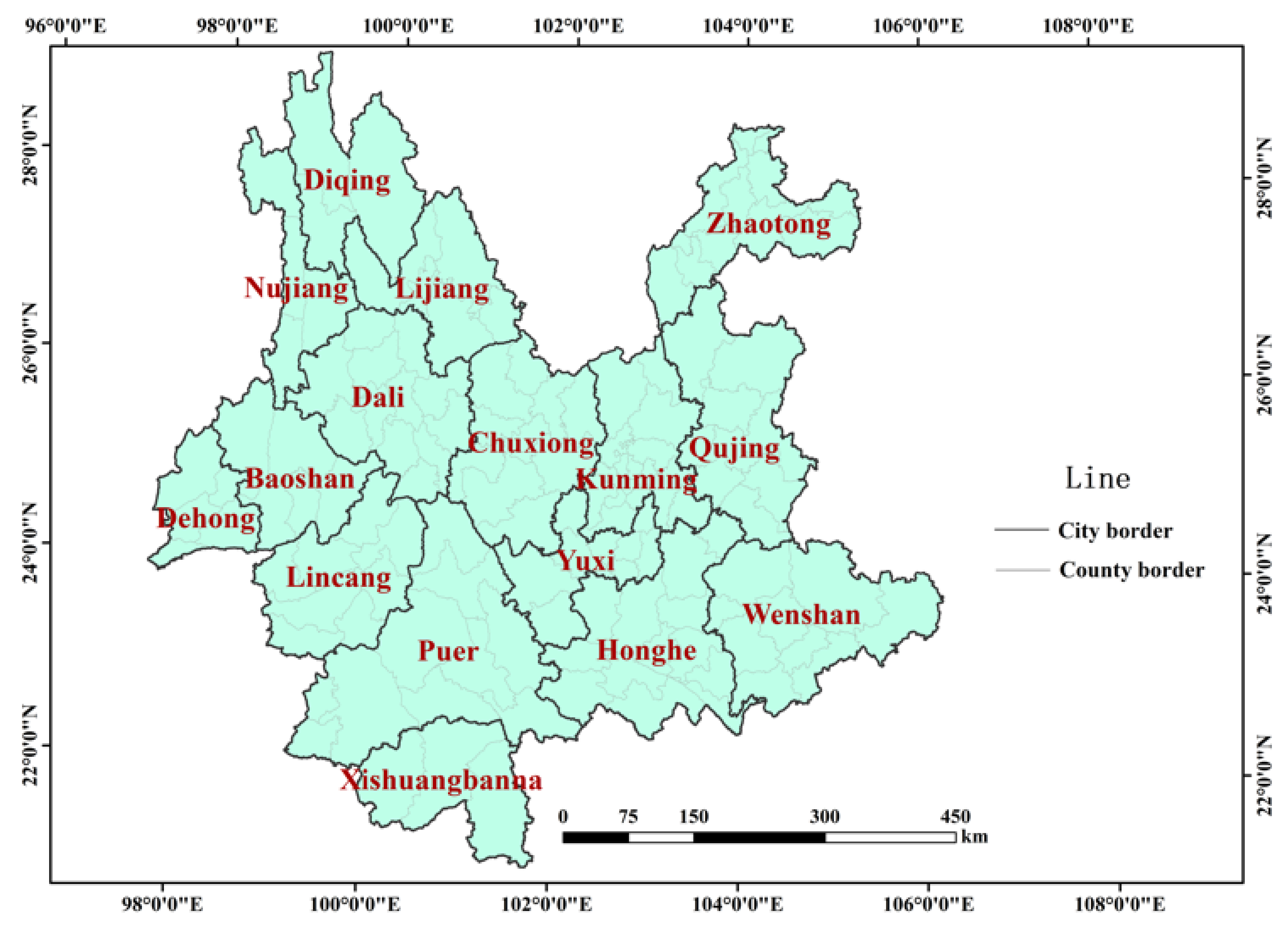
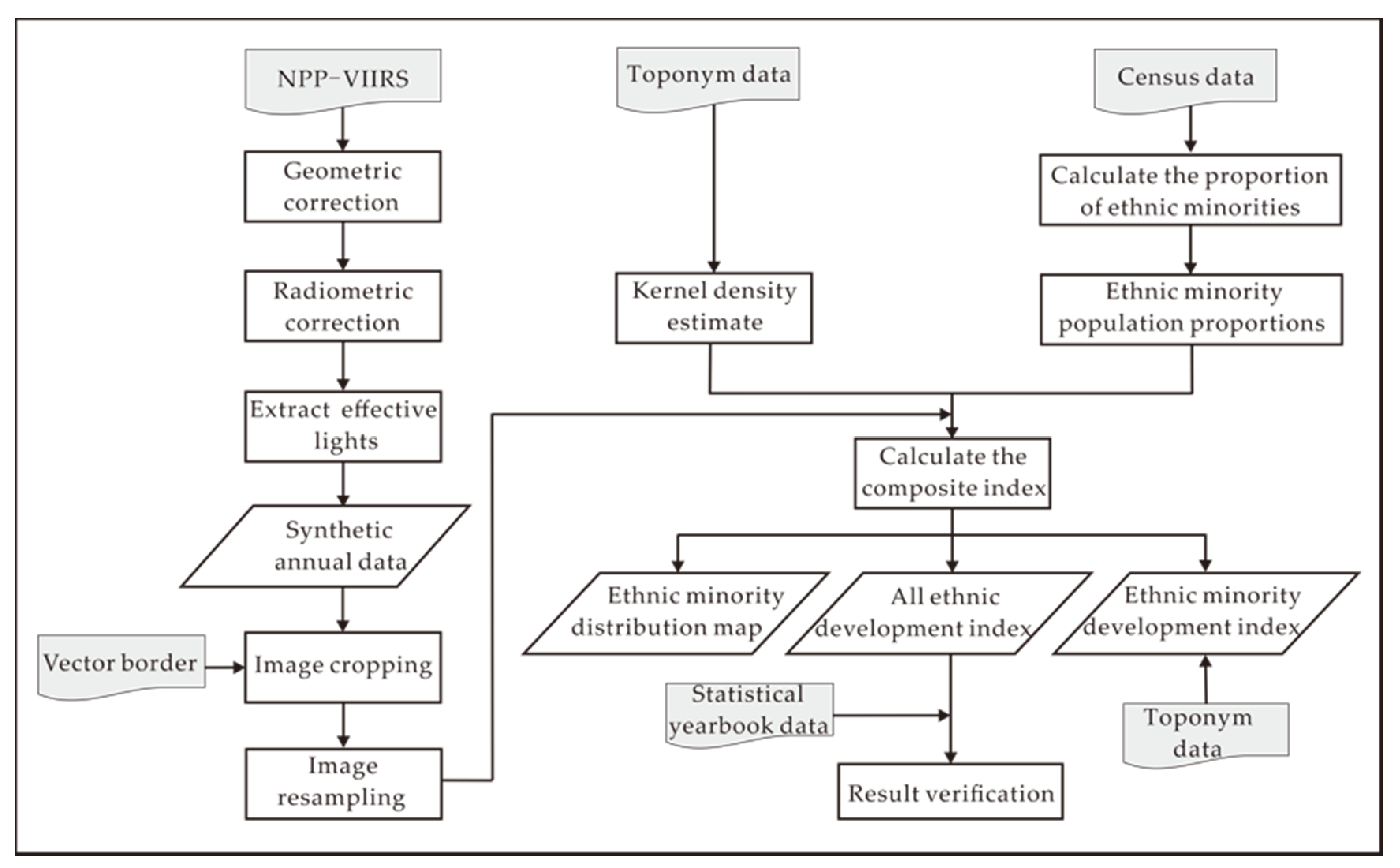

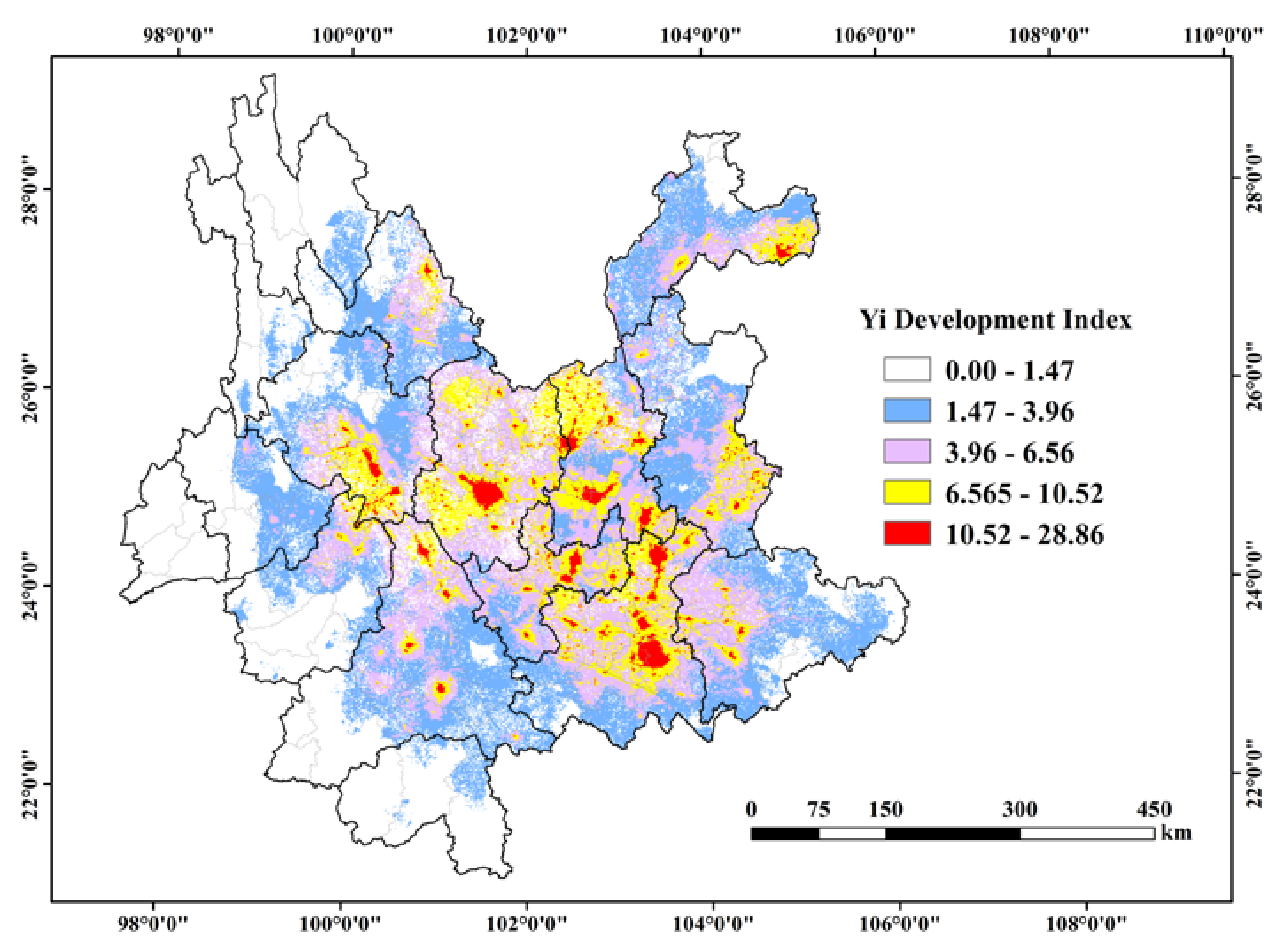

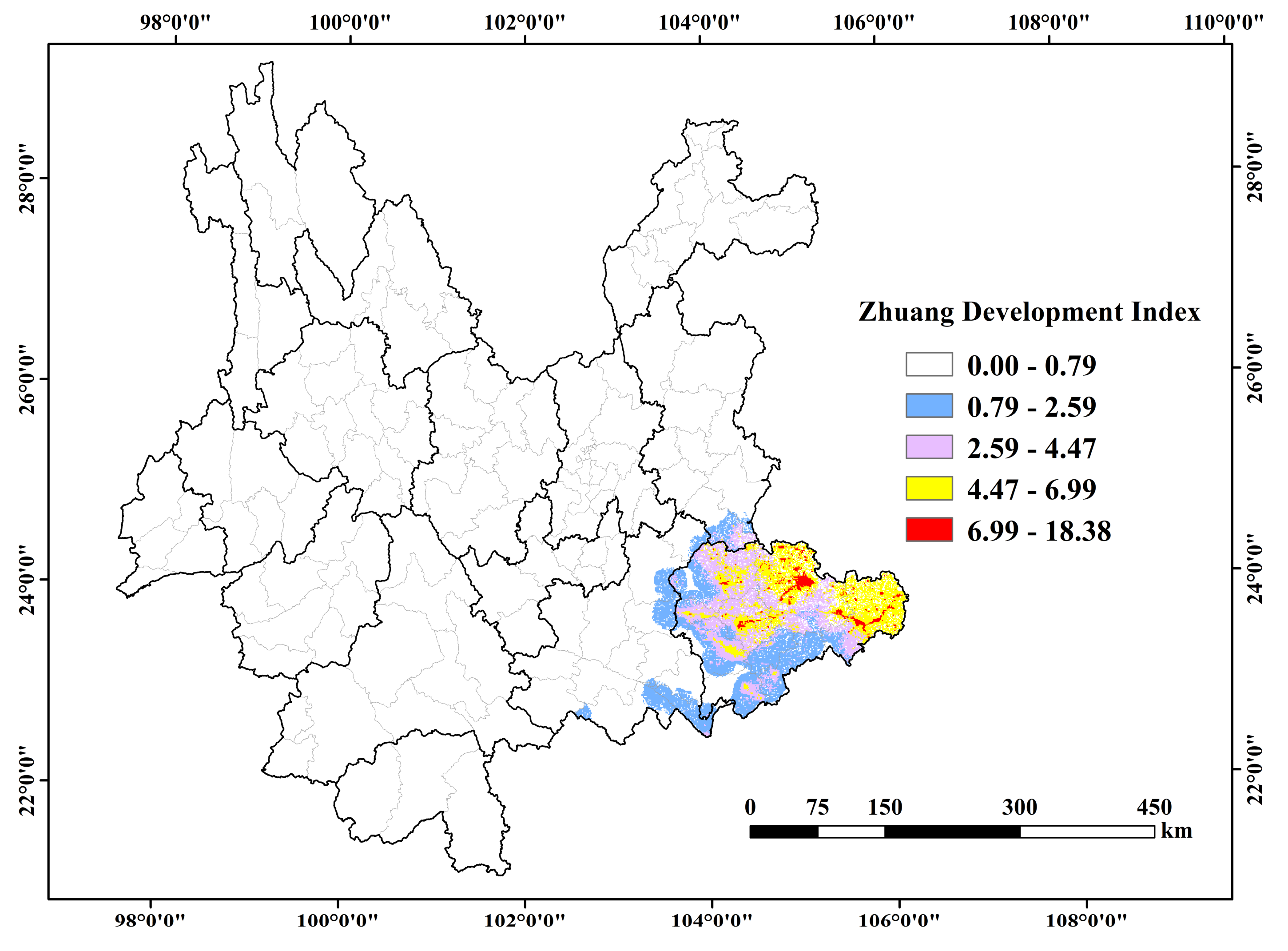


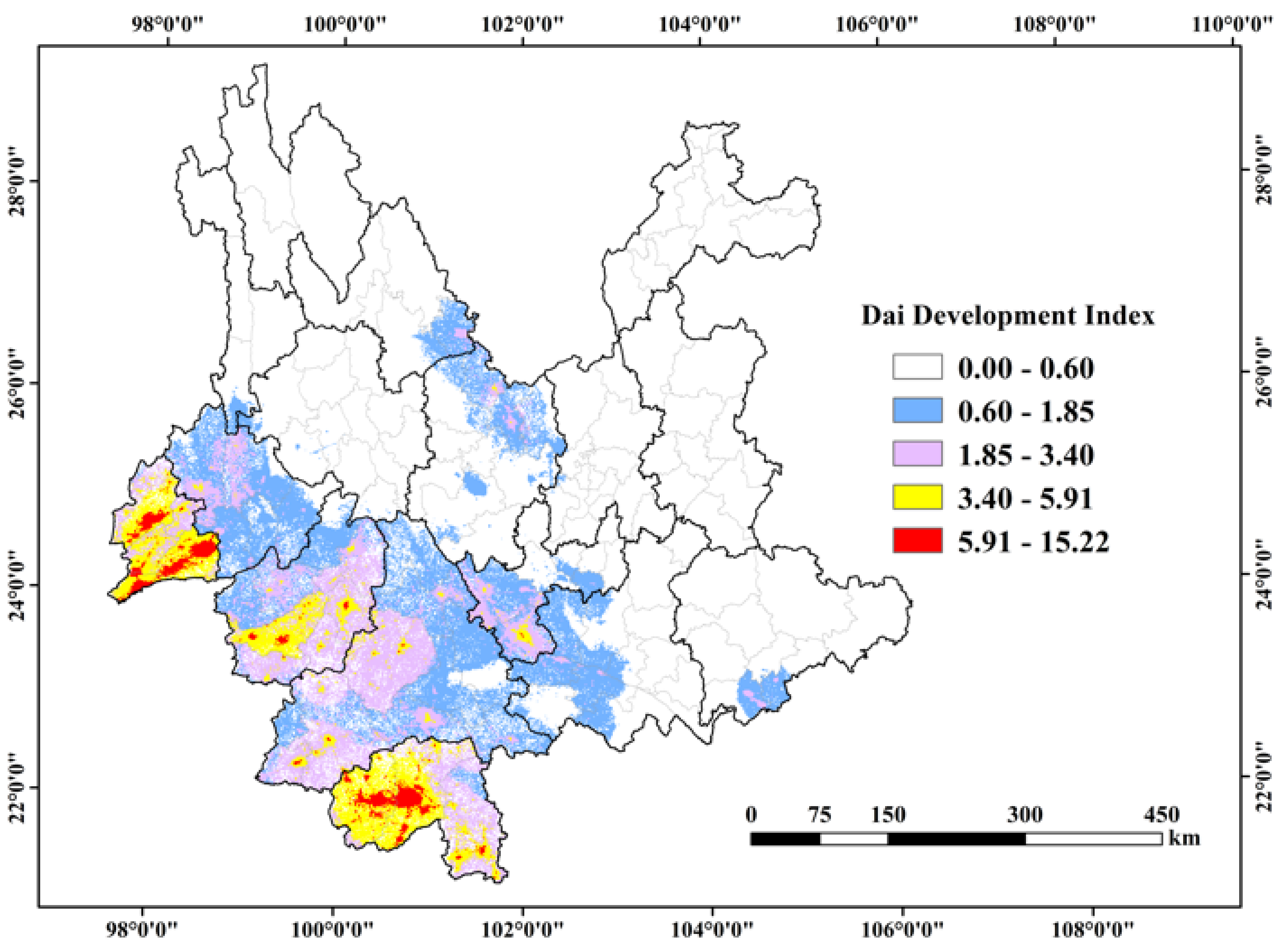
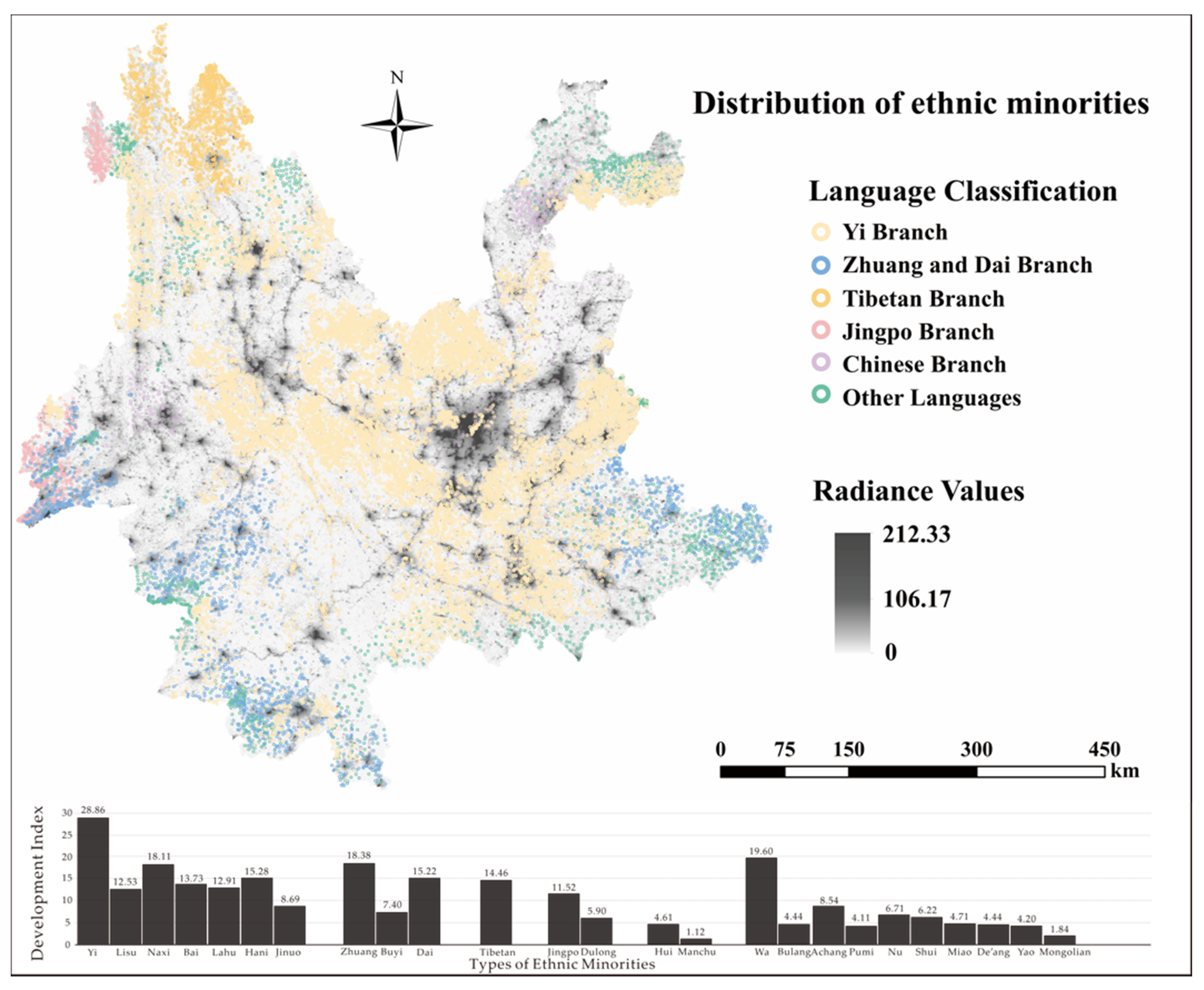
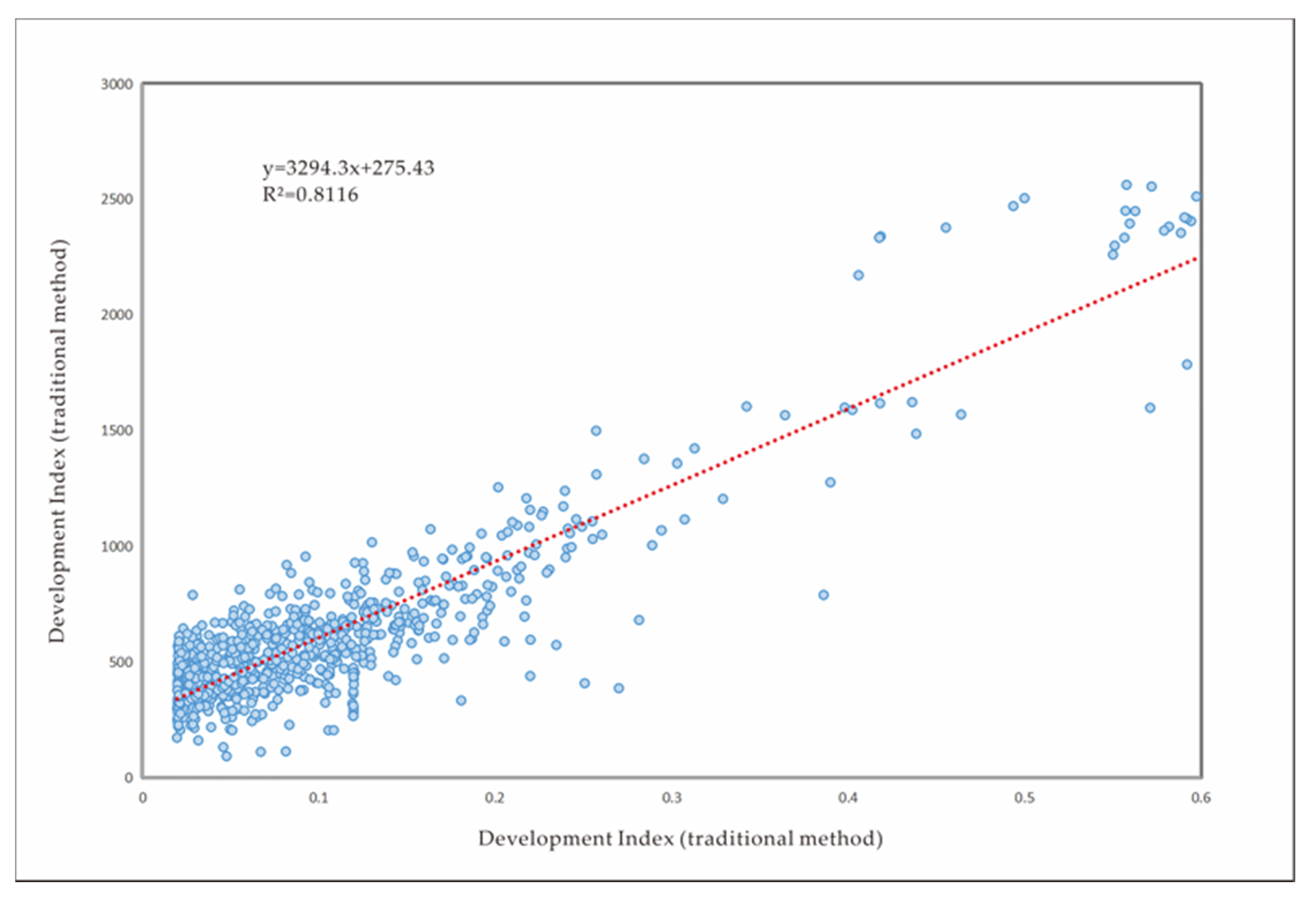
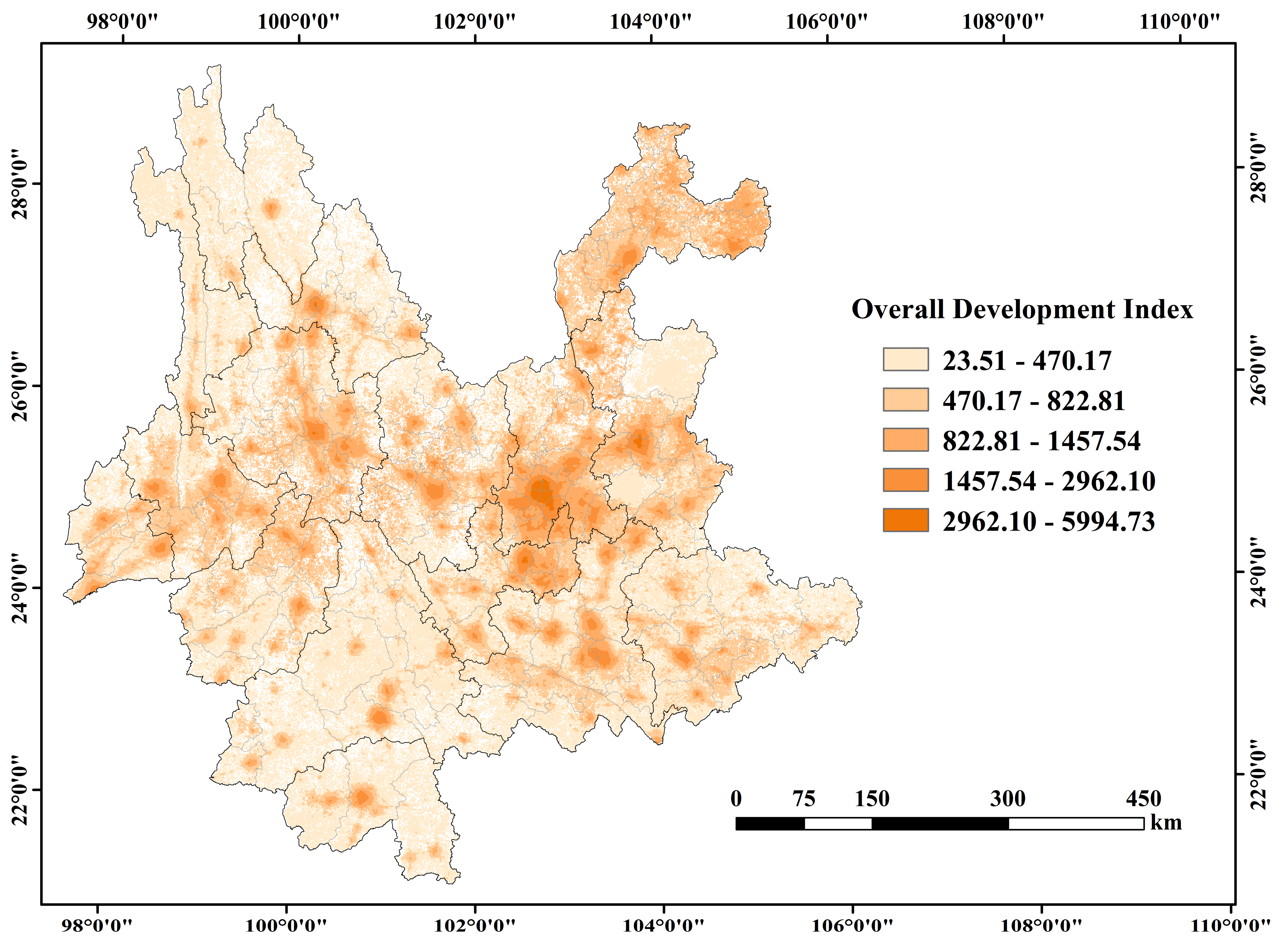
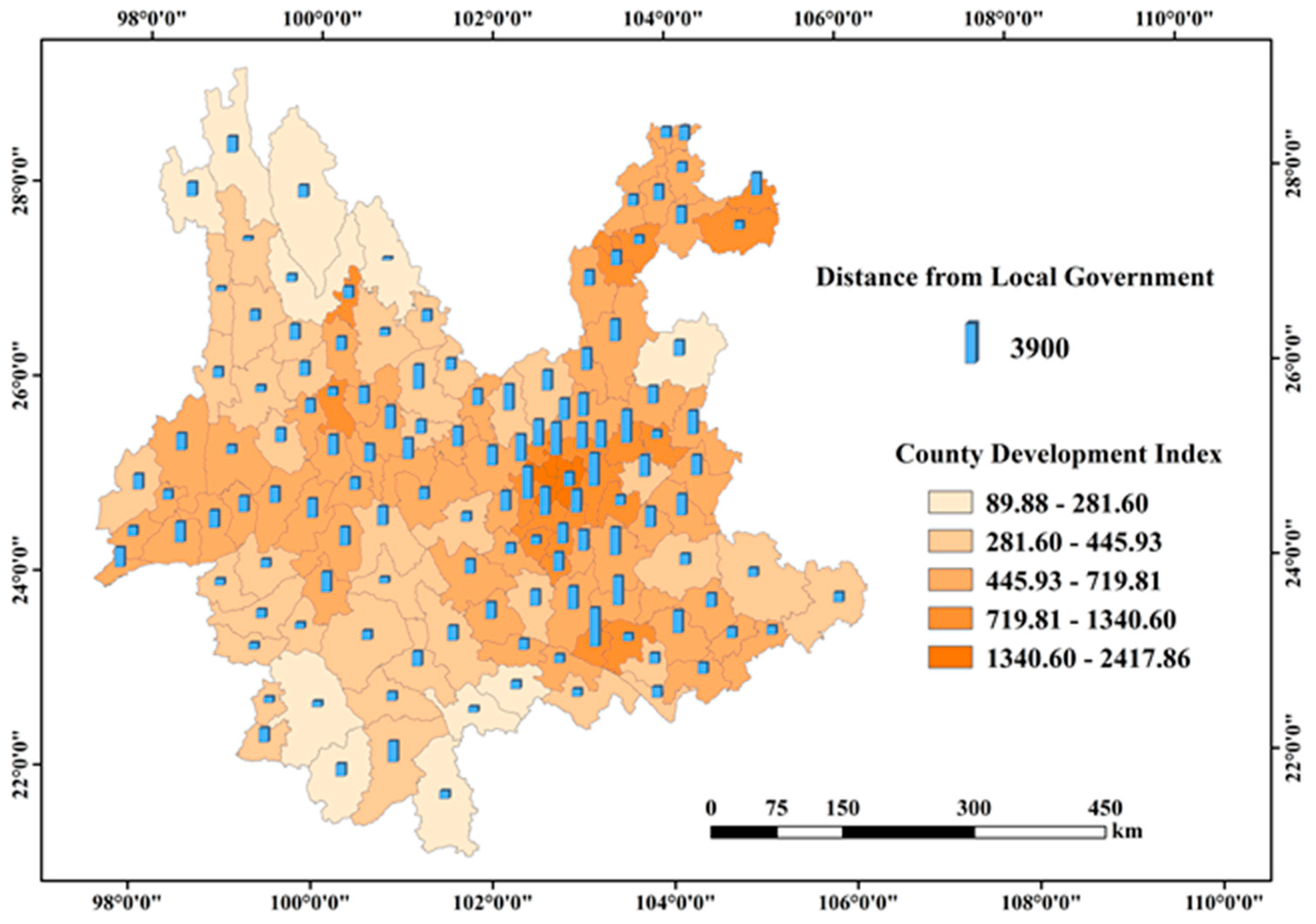
| Data | Data Information | Year | Source |
|---|---|---|---|
| NPP-VIIRS | NPP-VIIRS cloudless DNB compound monthly average data | 2018 | Earth Observation Group (EOG) (https://eogdata.mines.edu/download_dnb_composites.html, accessed on 28 May 2020) |
| Toponym | Results of the Second National Toponymic Census of China | 2019 | China National Geographical Names Database (http://dmfw.mca.gov.cn/, accessed on 20 May 2020) |
| Statistics of Yunnan Province Census | Data from the Sixth Census of Yunnan Province | 2010 | China Social Big Data Research Platform (http://data.cnki.net/, accessed on 14 June 2020) |
| Boundaries of county-level administrative divisions in Yunnan Province | County-level vector data in Yunnan Province | 2017 | National Basic Geographic Information Center (http://www.ngcc.cn/ngcc/, accessed on 13 May 2019) |
| Yunnan Statistical Yearbook Data | Socio-economic indicators of Yunnan Province | 2013–2018 | People’s Government of Yunnan Province (www.yn.gov.cn, accessed on 2 May 2021) |
| Branch | Ethnic Minority |
|---|---|
| Yi Branch | Yi, Lisu, Naxi, Bai, Lahu, Hani, Jinuo |
| Zhuang and Dai Branch | Zhuang, Buyi, Dai |
| Tibetan Branch | Tibetan |
| Jingpo Branch | Jingpo, Dulong |
| Chinese Branch | Hui, Manchu |
| Other Languages | Achang (Burmese branch), Shui (Dong Shui branch), Pumi; Nu; Mongolian, Deang (Undecided language), Miao (Miao branch), Yao (Yao branch), Wa; Bulang (Benglong language branch) |
| Year | 2013 | 2014 | 2015 | 2016 | 2017 | 2018 | |
|---|---|---|---|---|---|---|---|
| Indicators | |||||||
| GDP per capita | 0.1446 | 0.1401 | 0.1350 | 0.1304 | 0.1321 | 0.1330 | |
| GDP Index | 0.0419 | 0.0152 | 0.0252 | 0.0183 | 0.0144 | 0.0277 | |
| Number of employees | 0.3597 | 0.3630 | 0.3752 | 0.3732 | 0.3755 | 0.3716 | |
| Average salary of employees | 0.0057 | 0.0059 | 0.0052 | 0.0086 | 0.0090 | 0.0093 | |
| Per capita disposable income of rural residents | 0.0171 | 0.0239 | 0.0232 | 0.0230 | 0.0225 | 0.0222 | |
| Total output value of agriculture, forestry, animal husbandry and fishery | 0.1569 | 0.1503 | 0.1456 | 0.1453 | 0.1444 | 0.1438 | |
| Rural population | 0.1636 | 0.1646 | 0.1649 | 0.1667 | 0.1641 | 0.1665 | |
| Rural workers | 0.1520 | 0.1507 | 0.1507 | 0.1526 | 0.1523 | 0.1533 | |
| Year | 2013 | 2014 | 2015 | 2016 | 2017 | 2018 | |
|---|---|---|---|---|---|---|---|
| County | |||||||
| Wuhua | 0.5565 | 0.4184 | 0.4553 | 0.5595 | 0.5919 | 0.5626 | |
| Panlong | 0.4935 | 0.5719 | 0.4175 | 0.5943 | 0.4999 | 0.5973 | |
| Guandu | 0.4058 | 0.5501 | 0.5886 | 0.5818 | 0.5571 | 0.5577 | |
| Xishan | 0.4362 | 0.5920 | 0.3979 | 0.3641 | 0.5711 | 0.3423 | |
| Dongchuan | 0.2069 | 0.1855 | 0.1970 | 0.1763 | 0.1263 | 0.1595 | |
| Chenggong | 0.1706 | 0.2412 | 0.3289 | 0.5510 | 0.5790 | 0.5906 | |
| Jinning | 0.2200 | 0.1880 | 0.1278 | 0.1258 | 0.1740 | 0.1603 | |
| Fumin | 0.0309 | 0.1454 | 0.1275 | 0.0793 | 0.0285 | 0.1881 | |
| Yiliang | 0.0802 | 0.1650 | 0.1813 | 0.2292 | 0.2224 | 0.2432 | |
| Shilin | 0.1635 | 0.3860 | 0.0723 | 0.1983 | 0.1256 | 0.1756 | |
| Songming | 0.2307 | 0.1250 | 0.1700 | 0.1531 | 0.2550 | 0.2424 | |
| Luquan | 0.1190 | 0.0354 | 0.0404 | 0.2198 | 0.0635 | 0.0625 | |
| Xundian | 0.0482 | 0.0228 | 0.1243 | 0.1005 | 0.0759 | 0.0975 | |
| Anning | 0.1812 | 0.0925 | 0.1538 | 0.2232 | 0.2606 | 0.2492 | |
| Qilin | 0.2941 | 0.2193 | 0.2126 | 0.3072 | 0.2386 | 0.2395 | |
| Malong | 0.1123 | 0.1928 | 0.1693 | 0.0839 | 0.1293 | 0.2136 | |
| Luliang | 0.1289 | 0.1170 | 0.0310 | 0.0507 | 0.1856 | 0.0680 | |
| Shizong | 0.0929 | 0.0283 | 0.1104 | 0.0220 | 0.0602 | 0.1154 | |
| Luoping | 0.0533 | 0.0200 | 0.1049 | 0.1091 | 0.1217 | 0.1467 | |
| Fuyuan | 0.1455 | 0.1421 | 0.1275 | 0.1070 | 0.1327 | 0.1951 | |
| Huize | 0.1337 | 0.1262 | 0.0275 | 0.0728 | 0.0610 | 0.0458 | |
| Zhanyi | 0.1868 | 0.1564 | 0.1065 | 0.0506 | 0.0582 | 0.1565 | |
| Xuanwei | 0.1228 | 0.1014 | 0.1931 | 0.0926 | 0.1288 | 0.1064 | |
| Hongta | 0.3898 | 0.2574 | 0.2017 | 0.2177 | 0.3029 | 0.2844 | |
| Jiangchuan | 0.2124 | 0.2147 | 0.1954 | 0.1948 | 0.2097 | 0.2263 | |
| Chengjiang | 0.2890 | 0.2553 | 0.2037 | 0.1633 | 0.2272 | 0.2198 | |
| Tonghai | 0.1425 | 0.0818 | 0.1842 | 0.2408 | 0.2071 | 0.2459 | |
| Huaning | 0.0806 | 0.0789 | 0.1427 | 0.0529 | 0.1255 | 0.1587 | |
| Yimen | 0.0270 | 0.1556 | 0.1092 | 0.0388 | 0.0239 | 0.1186 | |
| Eshan | 0.1073 | 0.1150 | 0.0641 | 0.1003 | 0.0377 | 0.1089 | |
| Xinping | 0.0507 | 0.1436 | 0.0201 | 0.0203 | 0.1204 | 0.1154 | |
| Yuanjiang | 0.0563 | 0.0205 | 0.0623 | 0.0751 | 0.0713 | 0.1310 | |
| Longyang | 0.0422 | 0.0615 | 0.1098 | 0.0220 | 0.0541 | 0.0646 | |
| Shidian | 0.0196 | 0.0898 | 0.0342 | 0.0203 | 0.0542 | 0.1068 | |
| Tengchong | 0.0290 | 0.0575 | 0.0766 | 0.0439 | 0.0550 | 0.1588 | |
| Longling | 0.1197 | 0.0751 | 0.0888 | 0.0423 | 0.0244 | 0.0209 | |
| Changning | 0.0450 | 0.0403 | 0.0283 | 0.0782 | 0.0783 | 0.1131 | |
| Zhaoyang | 0.1454 | 0.0551 | 0.1440 | 0.1380 | 0.1399 | 0.1832 | |
| Ludian | 0.0938 | 0.1802 | 0.1376 | 0.1312 | 0.1831 | 0.2062 | |
| Qiaojia | 0.1017 | 0.0723 | 0.0385 | 0.0712 | 0.0211 | 0.1004 | |
| Yanjin | 0.0391 | 0.0204 | 0.0759 | 0.0422 | 0.1075 | 0.1131 | |
| Daguan | 0.1040 | 0.0895 | 0.0613 | 0.1594 | 0.1380 | 0.1172 | |
| Yongshan | 0.1071 | 0.1135 | 0.0575 | 0.1412 | 0.0964 | 0.0843 | |
| Suijiang | 0.1458 | 0.0706 | 0.0896 | 0.0864 | 0.0877 | 0.0756 | |
| Zhenxiong | 0.0600 | 0.0408 | 0.0878 | 0.0424 | 0.0297 | 0.0558 | |
| Yiliang | 0.1195 | 0.1198 | 0.1100 | 0.0821 | 0.0885 | 0.1049 | |
| Weixin | 0.0859 | 0.0209 | 0.0809 | 0.1667 | 0.1223 | 0.0757 | |
| Shuifu | 0.0223 | 0.0302 | 0.0634 | 0.0380 | 0.0706 | 0.1554 | |
| Gucheng | 0.0924 | 0.0613 | 0.0887 | 0.0946 | 0.1542 | 0.1332 | |
| Yulong | 0.0197 | 0.0201 | 0.0578 | 0.0211 | 0.0302 | 0.0342 | |
| Yongsheng | 0.0447 | 0.0215 | 0.0626 | 0.0393 | 0.0251 | 0.0568 | |
| Huaping | 0.0271 | 0.0917 | 0.0322 | 0.0201 | 0.0556 | 0.0243 | |
| Ninglang | 0.0247 | 0.0216 | 0.0632 | 0.0393 | 0.1433 | 0.0790 | |
| Simao | 0.0651 | 0.0913 | 0.0317 | 0.0801 | 0.0302 | 0.0564 | |
| Ning’er | 0.0214 | 0.0308 | 0.0895 | 0.0216 | 0.0480 | 0.1134 | |
| Mojiang | 0.0253 | 0.0327 | 0.0297 | 0.0344 | 0.0605 | 0.0199 | |
| Jingdong | 0.0474 | 0.1037 | 0.0204 | 0.1062 | 0.1195 | 0.0205 | |
| Jinggu | 0.1055 | 0.1084 | 0.0374 | 0.0449 | 0.0464 | 0.0528 | |
| Zhenyuan | 0.0360 | 0.0397 | 0.0409 | 0.0687 | 0.0601 | 0.0623 | |
| Jiangcheng | 0.0264 | 0.0302 | 0.0202 | 0.0435 | 0.1008 | 0.0237 | |
| Menglian | 0.0294 | 0.0202 | 0.0457 | 0.0207 | 0.0453 | 0.0267 | |
| Lancang | 0.0671 | 0.0458 | 0.0204 | 0.0510 | 0.0640 | 0.1807 | |
| Ximeng | 0.0813 | 0.0196 | 0.0208 | 0.0767 | 0.0207 | 0.2507 | |
| Linxiang | 0.0295 | 0.0204 | 0.1297 | 0.0450 | 0.0535 | 0.0206 | |
| Fengqing | 0.0199 | 0.1145 | 0.0513 | 0.0888 | 0.0207 | 0.1274 | |
| Yunxian | 0.0334 | 0.0656 | 0.0211 | 0.0209 | 0.0321 | 0.0962 | |
| Yongde | 0.0273 | 0.0264 | 0.0206 | 0.0403 | 0.1061 | 0.1245 | |
| Zhenkang | 0.1196 | 0.0242 | 0.1059 | 0.0640 | 0.0198 | 0.0520 | |
| Shuangjiang | 0.0833 | 0.0486 | 0.0206 | 0.0440 | 0.0528 | 0.0883 | |
| Gengma | 0.0389 | 0.0459 | 0.0480 | 0.0325 | 0.0205 | 0.0563 | |
| Cangyuan | 0.0317 | 0.0201 | 0.0312 | 0.0276 | 0.0352 | 0.0569 | |
| Chuxiong | 0.0251 | 0.0231 | 0.1089 | 0.0338 | 0.2816 | 0.1152 | |
| Shuangbo | 0.0299 | 0.0536 | 0.0210 | 0.1057 | 0.0997 | 0.0580 | |
| Mouding | 0.1196 | 0.0204 | 0.1000 | 0.1567 | 0.2166 | 0.1957 | |
| Nanhua | 0.0581 | 0.0204 | 0.1086 | 0.0968 | 0.1148 | 0.1205 | |
| Yao’an | 0.0496 | 0.0685 | 0.0392 | 0.0620 | 0.0336 | 0.0608 | |
| Dayao | 0.0471 | 0.0208 | 0.0578 | 0.0443 | 0.0625 | 0.0219 | |
| Yongren | 0.0384 | 0.0339 | 0.0499 | 0.0897 | 0.0200 | 0.0800 | |
| Yuanmou | 0.0200 | 0.0208 | 0.0824 | 0.0914 | 0.0456 | 0.0410 | |
| Wuding | 0.0621 | 0.0281 | 0.0825 | 0.0366 | 0.0553 | 0.2346 | |
| Lufeng | 0.0287 | 0.0322 | 0.0937 | 0.0561 | 0.1170 | 0.1709 | |
| Mengzi | 0.0761 | 0.0203 | 0.0214 | 0.0760 | 0.1079 | 0.0890 | |
| Gejiu | 0.0284 | 0.1278 | 0.1015 | 0.0870 | 0.1264 | 0.1201 | |
| Kaiyuan | 0.0455 | 0.1137 | 0.1624 | 0.1265 | 0.1662 | 0.1792 | |
| Mile | 0.0906 | 0.1955 | 0.1257 | 0.1705 | 0.1895 | 0.1721 | |
| Pingbian | 0.0353 | 0.0507 | 0.0206 | 0.0807 | 0.1048 | 0.0269 | |
| Jianshui | 0.0201 | 0.0705 | 0.0245 | 0.0418 | 0.1063 | 0.0564 | |
| Shiping | 0.0199 | 0.0380 | 0.1395 | 0.0611 | 0.1143 | 0.0946 | |
| Luxi | 0.1447 | 0.0652 | 0.0994 | 0.0891 | 0.0717 | 0.0992 | |
| Yuanyang | 0.0199 | 0.0638 | 0.0708 | 0.0309 | 0.0922 | 0.0706 | |
| Honghe | 0.0230 | 0.1195 | 0.0217 | 0.0256 | 0.0238 | 0.1657 | |
| Jinping | 0.0509 | 0.0202 | 0.0208 | 0.0207 | 0.0317 | 0.0206 | |
| Luchun | 0.0477 | 0.0621 | 0.0290 | 0.0359 | 0.0618 | 0.0369 | |
| Hekou | 0.0678 | 0.0488 | 0.0540 | 0.0390 | 0.0466 | 0.0206 | |
| Wenshan | 0.1196 | 0.0734 | 0.0784 | 0.0527 | 0.1758 | 0.1454 | |
| Yanshan | 0.0590 | 0.0655 | 0.0204 | 0.0804 | 0.0204 | 0.1157 | |
| Xichou | 0.1082 | 0.0495 | 0.0737 | 0.0613 | 0.0949 | 0.1313 | |
| Malipo | 0.1195 | 0.1039 | 0.0898 | 0.0211 | 0.1296 | 0.2052 | |
| Maguan | 0.0538 | 0.0537 | 0.0206 | 0.0208 | 0.0878 | 0.1211 | |
| Qiubei | 0.0212 | 0.0522 | 0.0347 | 0.0264 | 0.0746 | 0.0210 | |
| Guangnan | 0.1195 | 0.0275 | 0.0352 | 0.0208 | 0.0579 | 0.0204 | |
| Funing | 0.0200 | 0.0202 | 0.0390 | 0.0370 | 0.0244 | 0.0225 | |
| Jinghong | 0.0339 | 0.0985 | 0.1048 | 0.1219 | 0.1242 | 0.0996 | |
| Menghai | 0.0286 | 0.0216 | 0.0309 | 0.0324 | 0.0738 | 0.0533 | |
| Mengla | 0.0546 | 0.1012 | 0.1310 | 0.1316 | 0.0516 | 0.1163 | |
| Dali | 0.2015 | 0.1204 | 0.2399 | 0.2192 | 0.1301 | 0.1922 | |
| Yangbi | 0.0202 | 0.0489 | 0.0407 | 0.0577 | 0.1129 | 0.0841 | |
| Xiangyun | 0.0971 | 0.0307 | 0.0752 | 0.0860 | 0.1438 | 0.1869 | |
| Binchuan | 0.0358 | 0.1710 | 0.0278 | 0.0977 | 0.1210 | 0.0878 | |
| Midu | 0.0577 | 0.1017 | 0.0822 | 0.1511 | 0.0946 | 0.1239 | |
| Nanjian | 0.0218 | 0.0967 | 0.0246 | 0.0510 | 0.1526 | 0.0868 | |
| Weishan | 0.0534 | 0.1220 | 0.0705 | 0.1026 | 0.0599 | 0.0919 | |
| Yongping | 0.0740 | 0.0848 | 0.0351 | 0.0952 | 0.0422 | 0.0622 | |
| Yunlong | 0.0422 | 0.1352 | 0.0734 | 0.1527 | 0.1387 | 0.2176 | |
| Eryuan | 0.0214 | 0.0419 | 0.0310 | 0.0206 | 0.0202 | 0.1260 | |
| Jianchuan | 0.0379 | 0.0366 | 0.0211 | 0.0832 | 0.1196 | 0.0851 | |
| Heqing | 0.0715 | 0.0213 | 0.0658 | 0.0636 | 0.0688 | 0.0851 | |
| Mangshi | 0.0200 | 0.1012 | 0.1463 | 0.1428 | 0.1542 | 0.0607 | |
| Ruili | 0.0626 | 0.1126 | 0.0557 | 0.0518 | 0.1487 | 0.2090 | |
| Lianghe | 0.0343 | 0.1255 | 0.0221 | 0.0202 | 0.1423 | 0.1570 | |
| Yingjiang | 0.1195 | 0.0694 | 0.1095 | 0.0374 | 0.2701 | 0.0613 | |
| Longchuan | 0.0256 | 0.0949 | 0.0204 | 0.0198 | 0.0495 | 0.1184 | |
| Lushui | 0.0209 | 0.0219 | 0.0874 | 0.1034 | 0.0254 | 0.0943 | |
| Fugong | 0.0289 | 0.0288 | 0.0217 | 0.0427 | 0.0465 | 0.0644 | |
| Gongshan | 0.0204 | 0.0498 | 0.0332 | 0.1214 | 0.0707 | 0.0924 | |
| Lanping | 0.0272 | 0.0383 | 0.0282 | 0.0199 | 0.0686 | 0.0912 | |
| Shangri-La | 0.3128 | 0.4385 | 0.2572 | 0.4639 | 0.4023 | 0.4179 | |
| Deqin | 0.0506 | 0.0309 | 0.0282 | 0.0950 | 0.0798 | 0.0859 | |
| Weixi | 0.0772 | 0.0261 | 0.0730 | 0.1198 | 0.0490 | 0.0460 | |
| Year | 2013 | 2014 | 2015 | 2016 | 2017 | 2018 | |
|---|---|---|---|---|---|---|---|
| County | |||||||
| Wuhua | 2333.1825 | 2339.1373 | 2376.7834 | 2394.4854 | 2415.8620 | 2448.1288 | |
| Panlong | 2470.0052 | 2554.7521 | 2333.1047 | 2404.9305 | 2504.0174 | 2511.2501 | |
| Guandu | 2170.9487 | 2259.7741 | 2353.8594 | 2381.0156 | 2449.4958 | 2561.8397 | |
| Xishan | 1621.7904 | 1784.9426 | 1598.3018 | 1565.5310 | 1597.4138 | 1602.9692 | |
| Dongchuan | 960.6572 | 994.8467 | 742.9193 | 836.3549 | 854.5164 | 934.8275 | |
| Chenggong | 943.5753 | 1076.5617 | 1205.3264 | 2298.8631 | 2363.8025 | 2420.8939 | |
| Jinning | 595.8789 | 627.4076 | 688.4572 | 711.8920 | 830.7505 | 850.9899 | |
| Fumin | 612.8931 | 695.4732 | 746.5198 | 784.6463 | 789.6833 | 897.2893 | |
| Yiliang | 625.2049 | 761.7744 | 830.1322 | 886.5681 | 962.0898 | 996.5625 | |
| Shilin | 766.8347 | 789.6061 | 794.6279 | 825.1524 | 891.7881 | 985.6760 | |
| Songming | 899.6777 | 927.3485 | 946.6784 | 973.7795 | 1107.7790 | 1056.7363 | |
| Luquan | 320.2183 | 364.9809 | 400.2450 | 438.9507 | 448.5508 | 576.7864 | |
| Xundian | 517.4374 | 522.8907 | 539.6836 | 574.8628 | 601.3995 | 746.0349 | |
| Anning | 945.3103 | 955.8508 | 957.5187 | 1008.2649 | 1050.5527 | 1084.9657 | |
| Qilin | 1069.2507 | 1084.1809 | 1090.9449 | 1116.4519 | 1172.8232 | 1240.0189 | |
| Malong | 649.2351 | 693.1274 | 712.2659 | 729.2838 | 757.7143 | 860.7674 | |
| Luliang | 543.4304 | 554.4877 | 576.5027 | 589.5539 | 595.1228 | 638.4553 | |
| Shizong | 483.0773 | 485.1854 | 500.8513 | 519.5551 | 526.3722 | 657.7111 | |
| Luoping | 491.1515 | 417.1506 | 518.5569 | 531.6147 | 554.2872 | 672.6678 | |
| Fuyuan | 633.7029 | 641.5798 | 652.7819 | 663.3065 | 674.2953 | 782.7485 | |
| Huize | 617.1130 | 647.3857 | 481.3886 | 507.0445 | 558.0216 | 605.9378 | |
| Zhanyi | 600.3138 | 635.8879 | 660.7369 | 673.4620 | 696.3811 | 843.4202 | |
| Xuanwei | 623.7029 | 656.5798 | 662.7819 | 673.3065 | 684.2953 | 796.7485 | |
| Hongta | 1276.6486 | 1310.7777 | 1255.3083 | 1207.8354 | 1358.3035 | 1377.4974 | |
| Jiangchuan | 897.7480 | 912.4791 | 947.5681 | 952.9043 | 1104.6690 | 1133.9384 | |
| Chengjiang | 1004.5388 | 1031.805437 | 1047.223082 | 1074.157544 | 1149.89266 | 1157.818511 | |
| Tonghai | 883.0552 | 919.5813 | 957.5814 | 990.6898 | 1062.5763 | 1117.2477 | |
| Huaning | 585.7714 | 595.2825 | 640.7928 | 658.2505 | 715.3348 | 811.3422 | |
| Yimen | 494.4001 | 511.3989 | 532.8776 | 551.4176 | 555.8165 | 693.6572 | |
| Eshan | 489.2267 | 549.9414 | 580.4157 | 593.6294 | 615.8568 | 664.5724 | |
| Xinping | 260.6868 | 421.3788 | 415.0625 | 415.7112 | 453.7176 | 537.3233 | |
| Yuanjiang | 486.8459 | 539.9640 | 559.4845 | 596.8433 | 624.0441 | 689.0722 | |
| Longyang | 433.3167 | 507.6858 | 521.9453 | 535.2050 | 590.8690 | 664.5847 | |
| Shidian | 297.5054 | 455.6399 | 417.2362 | 473.0716 | 502.3391 | 582.7547 | |
| Tengchong | 381.8499 | 569.4589 | 552.5687 | 604.0656 | 669.7669 | 753.0422 | |
| Longling | 283.7437 | 472.8197 | 460.4084 | 499.1058 | 498.2598 | 612.5852 | |
| Changning | 299.6858 | 441.3997 | 467.5553 | 447.8070 | 469.2807 | 565.8577 | |
| Zhaoyang | 803.7647 | 813.1024 | 880.7033 | 856.9120 | 885.1878 | 954.2087 | |
| Ludian | 640.0504 | 697.3706 | 741.4808 | 756.5885 | 772.3398 | 868.5031 | |
| Qiaojia | 461.1212 | 479.4775 | 498.7038 | 540.6888 | 592.3084 | 670.8998 | |
| Yanjin | 427.3850 | 495.8935 | 540.4706 | 557.9826 | 565.5458 | 616.2725 | |
| Daguan | 529.7191 | 622.5744 | 655.1364 | 689.8198 | 755.0185 | 767.3721 | |
| Yongshan | 696.0273 | 684.1769 | 741.3797 | 744.1170 | 810.3069 | 884.5728 | |
| Suijiang | 626.3479 | 600.9896 | 614.0467 | 641.6444 | 706.0032 | 718.7469 | |
| Zhenxiong | 448.4068 | 454.1750 | 578.5055 | 497.7722 | 473.2344 | 564.0579 | |
| Yiliang | 455.5056 | 426.6301 | 535.4907 | 578.2334 | 588.6284 | 642.6751 | |
| Weixin | 649.2141 | 576.1327 | 623.3148 | 665.7798 | 808.1880 | 817.0238 | |
| Shuifu | 477.7044 | 536.3990 | 554.4428 | 565.6362 | 624.9817 | 672.7901 | |
| Gucheng | 715.5696 | 656.3005 | 791.5617 | 844.6705 | 659.9559 | 730.8966 | |
| Yulong | 249.8526 | 278.7471 | 289.6164 | 322.6217 | 348.7171 | 434.7898 | |
| Yongsheng | 306.8789 | 315.7225 | 339.0830 | 358.6972 | 367.6797 | 455.4456 | |
| Huaping | 398.2136 | 435.1668 | 448.9292 | 465.1374 | 473.1283 | 529.3849 | |
| Ninglang | 483.3725 | 499.1192 | 503.1318 | 532.7423 | 568.5116 | 556.7700 | |
| Simao | 262.0737 | 378.4076 | 411.3063 | 423.9178 | 428.7674 | 515.5211 | |
| Ning’er | 205.7700 | 345.3506 | 377.4181 | 363.9567 | 380.2126 | 492.3221 | |
| Mojiang | 294.4344 | 320.0161 | 345.7805 | 360.6149 | 368.5020 | 492.5927 | |
| Jingdong | 285.6620 | 323.7440 | 442.4544 | 445.8952 | 451.9286 | 557.7185 | |
| Jinggu | 204.1723 | 204.5097 | 286.7719 | 300.7873 | 279.4673 | 347.8470 | |
| Zhenyuan | 316.8741 | 345.1779 | 366.7534 | 369.0427 | 369.2104 | 463.5557 | |
| Jiangcheng | 259.2867 | 353.5767 | 385.5516 | 390.8240 | 468.7765 | 490.3128 | |
| Menglian | 214.4475 | 261.5678 | 354.3153 | 353.2323 | 388.4604 | 440.2223 | |
| Lancang | 111.0612 | 131.2043 | 226.3668 | 288.6047 | 273.7476 | 333.1441 | |
| Ximeng | 112.9200 | 172.0400 | 326.1849 | 337.2044 | 349.1749 | 407.7943 | |
| Linxiang | 306.9635 | 462.6050 | 515.0650 | 507.7827 | 502.8663 | 588.0734 | |
| Fengqing | 380.4210 | 587.8980 | 589.8904 | 608.2613 | 611.0447 | 714.5013 | |
| Yunxian | 315.0365 | 499.6152 | 461.8195 | 532.8510 | 521.2354 | 619.7606 | |
| Yongde | 226.1955 | 423.5674 | 434.0769 | 478.3543 | 459.3394 | 528.0003 | |
| Zhenkang | 297.1114 | 355.5066 | 364.0461 | 370.0390 | 376.3777 | 433.9040 | |
| Shuangjiang | 227.5567 | 287.2707 | 326.3009 | 387.4047 | 401.0221 | 468.4001 | |
| Gengma | 217.7960 | 347.9124 | 396.2941 | 372.3042 | 356.5077 | 406.0964 | |
| Cangyuan | 160.4840 | 309.5874 | 338.4399 | 339.9750 | 354.0869 | 416.7235 | |
| Chuxiong | 433.2826 | 645.2557 | 653.4692 | 657.8736 | 681.1811 | 837.8980 | |
| Shuangbo | 252.8526 | 303.8850 | 379.6348 | 390.3115 | 407.8300 | 520.8493 | |
| Mouding | 310.4608 | 560.9061 | 615.7034 | 638.1917 | 696.1406 | 832.3970 | |
| Nanhua | 480.4072 | 505.4462 | 609.2866 | 625.6880 | 638.3771 | 782.9123 | |
| Yao’an | 209.0912 | 390.8838 | 467.7279 | 486.7033 | 523.6015 | 651.2314 | |
| Dayao | 252.5988 | 349.5919 | 369.2466 | 413.5369 | 424.8047 | 538.7005 | |
| Yongren | 345.9574 | 362.8734 | 373.2791 | 374.4745 | 446.5159 | 482.9805 | |
| Yuanmou | 339.6947 | 476.3847 | 520.1060 | 529.2911 | 571.1880 | 670.1142 | |
| Wuding | 247.2879 | 375.7019 | 384.2886 | 436.3690 | 459.5321 | 573.1000 | |
| Lufeng | 478.5784 | 580.9119 | 586.9430 | 591.4193 | 655.7322 | 748.1127 | |
| Mengzi | 457.9591 | 464.1473 | 470.5014 | 506.2215 | 511.0077 | 613.6647 | |
| Gejiu | 572.3553 | 600.1590 | 591.4074 | 642.3799 | 690.1944 | 748.6155 | |
| Kaiyuan | 668.0048 | 673.1953 | 604.3685 | 624.1396 | 766.4539 | 826.0011 | |
| Mile | 671.0291 | 722.1276 | 726.0442 | 747.2656 | 792.8220 | 868.9230 | |
| Pingbian | 305.4681 | 375.1979 | 417.6111 | 443.0900 | 444.3564 | 572.0882 | |
| Jianshui | 399.9278 | 458.7829 | 479.0721 | 504.5566 | 511.8208 | 618.5614 | |
| Shiping | 321.6694 | 424.4328 | 438.0587 | 446.9695 | 470.7730 | 563.0486 | |
| Luxi | 592.6135 | 609.4124 | 631.0997 | 645.3875 | 709.2802 | 801.2388 | |
| Yuanyang | 333.5136 | 363.3037 | 451.0659 | 478.7271 | 523.0667 | 617.0672 | |
| Honghe | 258.5071 | 372.6793 | 447.6026 | 464.3542 | 490.1732 | 609.1840 | |
| Jinping | 204.2935 | 221.5390 | 339.2894 | 356.5964 | 360.8186 | 465.1307 | |
| Luchun | 91.9753 | 243.7047 | 264.9559 | 309.4107 | 322.8647 | 434.3615 | |
| Hekou | 272.5834 | 350.7499 | 384.7263 | 391.4023 | 396.9577 | 475.4815 | |
| Wenshan | 474.0788 | 490.4182 | 499.7623 | 533.9054 | 594.8506 | 672.3611 | |
| Yanshan | 421.5922 | 437.0946 | 445.0354 | 464.4252 | 494.4376 | 596.4948 | |
| Xichou | 508.0878 | 515.4572 | 575.0413 | 617.1873 | 628.6801 | 727.9660 | |
| Malipo | 266.5631 | 402.8942 | 460.5780 | 461.5752 | 485.8210 | 588.7415 | |
| Maguan | 293.9284 | 356.8797 | 399.5391 | 404.3396 | 448.7799 | 523.6682 | |
| Qiubei | 331.6157 | 347.3116 | 384.0514 | 401.5665 | 404.9738 | 504.4938 | |
| Guangnan | 266.2608 | 293.2710 | 311.7878 | 352.7943 | 359.1112 | 454.3619 | |
| Funing | 240.5025 | 324.5929 | 340.5920 | 348.3029 | 363.3480 | 485.1750 | |
| Jinghong | 399.9671 | 410.0248 | 452.5865 | 539.5053 | 556.8493 | 620.9858 | |
| Menghai | 229.7981 | 276.6386 | 298.5195 | 306.0052 | 308.7728 | 339.3909 | |
| Mengla | 562.3500 | 597.2580 | 617.6430 | 697.8365 | 700.8417 | 782.5778 | |
| Dali | 894.2742 | 929.0856 | 952.3336 | 972.2778 | 1017.5021 | 1054.9061 | |
| Yangbi | 409.4086 | 504.7738 | 535.1718 | 541.4113 | 592.4125 | 669.4222 | |
| Xiangyun | 521.8522 | 635.7725 | 637.0776 | 639.2351 | 659.8403 | 773.7537 | |
| Binchuan | 477.8487 | 515.6735 | 532.8143 | 547.7162 | 554.5976 | 662.9385 | |
| Midu | 515.8058 | 614.6749 | 661.6881 | 669.8814 | 676.4856 | 796.9106 | |
| Nanjian | 410.8299 | 532.0153 | 545.4751 | 554.5118 | 581.0947 | 724.9630 | |
| Weishan | 495.9411 | 521.2475 | 521.6193 | 521.8876 | 559.1663 | 680.8504 | |
| Yongping | 440.5821 | 478.1848 | 494.3199 | 528.8982 | 518.7397 | 631.0074 | |
| Yunlong | 598.6572 | 619.4169 | 655.4769 | 698.7190 | 716.7159 | 765.8410 | |
| Eryuan | 365.9509 | 434.7853 | 446.9512 | 463.0531 | 471.9941 | 590.1621 | |
| Jianchuan | 312.4686 | 377.2469 | 403.1285 | 427.2047 | 436.7856 | 538.2106 | |
| Heqing | 398.3198 | 406.8919 | 437.4106 | 440.9969 | 508.3256 | 571.2813 | |
| Mangshi | 568.9163 | 643.5718 | 655.0890 | 658.2708 | 709.8286 | 727.3277 | |
| Ruili | 585.2299 | 621.4004 | 640.0733 | 722.0235 | 729.4622 | 804.0055 | |
| Lianghe | 343.3566 | 495.8395 | 512.3878 | 525.5199 | 542.1922 | 656.7071 | |
| Yingjiang | 361.4221 | 362.8221 | 365.1339 | 366.4192 | 386.2395 | 472.1552 | |
| Longchuan | 396.3737 | 424.4385 | 447.7375 | 450.1162 | 503.5420 | 574.8163 | |
| Lushui | 338.0632 | 425.1091 | 511.3545 | 528.6956 | 621.6195 | 678.0960 | |
| Fugong | 281.9702 | 301.0313 | 317.7124 | 378.3484 | 428.1135 | 499.3321 | |
| Gongshan | 449.5138 | 542.8045 | 564.2108 | 653.6538 | 657.6125 | 728.4643 | |
| Lanping | 379.1665 | 394.9759 | 399.0575 | 403.1246 | 427.0084 | 492.5050 | |
| Shangri-La | 1421.7904 | 1484.9426 | 1498.3018 | 1568.5310 | 1588.4138 | 1616.9692 | |
| Deqin | 491.5996 | 556.1296 | 606.6776 | 630.9152 | 639.8685 | 696.2319 | |
| Weixi | 378.2066 | 389.1270 | 389.1924 | 403.1409 | 415.1711 | 494.6600 | |
| National Development Level | Average Distance to the Nearest Government (Unit: m) |
|---|---|
| Excellent-Developed | 3352.28 |
| Well-Developed | 4695.77 |
| Medium-Developed | 6043.98 |
| Poor-Developed | 8728.84 |
| Very Poor-Developed | 12,411.90 |
Publisher’s Note: MDPI stays neutral with regard to jurisdictional claims in published maps and institutional affiliations. |
© 2021 by the authors. Licensee MDPI, Basel, Switzerland. This article is an open access article distributed under the terms and conditions of the Creative Commons Attribution (CC BY) license (https://creativecommons.org/licenses/by/4.0/).
Share and Cite
Zhao, F.; Song, L.; Peng, Z.; Yang, J.; Luan, G.; Chu, C.; Ding, J.; Feng, S.; Jing, Y.; Xie, Z. Night-Time Light Remote Sensing Mapping: Construction and Analysis of Ethnic Minority Development Index. Remote Sens. 2021, 13, 2129. https://doi.org/10.3390/rs13112129
Zhao F, Song L, Peng Z, Yang J, Luan G, Chu C, Ding J, Feng S, Jing Y, Xie Z. Night-Time Light Remote Sensing Mapping: Construction and Analysis of Ethnic Minority Development Index. Remote Sensing. 2021; 13(11):2129. https://doi.org/10.3390/rs13112129
Chicago/Turabian StyleZhao, Fei, Lu Song, Zhiyan Peng, Jianqin Yang, Guize Luan, Chen Chu, Jieyu Ding, Siwen Feng, Yuhang Jing, and Zhiqiang Xie. 2021. "Night-Time Light Remote Sensing Mapping: Construction and Analysis of Ethnic Minority Development Index" Remote Sensing 13, no. 11: 2129. https://doi.org/10.3390/rs13112129
APA StyleZhao, F., Song, L., Peng, Z., Yang, J., Luan, G., Chu, C., Ding, J., Feng, S., Jing, Y., & Xie, Z. (2021). Night-Time Light Remote Sensing Mapping: Construction and Analysis of Ethnic Minority Development Index. Remote Sensing, 13(11), 2129. https://doi.org/10.3390/rs13112129








